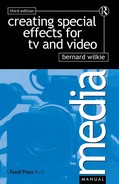Fog and Mist
To achieve the effects of fog or mist it is not always necessary to fill the studio with clouds of smoke. There are various aids to producing the desired effect, but each has its own applications and the problem should be thoroughly analysed before a method is chosen.
A foggy night
Night scenes provide better conditions than day for the simulation of fog. The dark backgrounds give greater contrast with the white swirling fog or mist and make it easier to see. Low key lighting also helps and this is more easily achieved in night scenes than in day. A moderate application of smoke behind the action gives a suitable effect if all back-lighting is switched off. A similar amount in front of the action completes the picture and as far as possible both areas should be front lit. The smoke should be passed over dry-ice to cool it and the studio ventilation system turned off for the duration of the sequence.
A foggy day
Conditions are the same as for the night sequence except that much more smoke has to be used. Lighting should be arranged so that it bounces back off the smoke rather than shines through it. Fog filters are available for TV and film cameras. A reasonable illusion can be created by superimposing a previously filmed fog effect – this is known as a ‘fog loop’ (see below).
Vignette
A vignette of white material placed in front of the lens softens the edges of the picture and by causing light to flare back into the camera creates a degraded image that augments smoke and other devices used. The effect must not be used where the camera pans around, because the treated area is then noticeable.
Superimposed effects
A reasonable illusion can be created by superimposing the effect. One of the best sources of superimposition is the fog loop. Smoke filmed against a black background can be superimposed over the main picture to give a realistic effect, but as it is slow moving it is impracticable to use the loop effect when rapid pans or cuts are necessary in the sequence. Cuts can be accepted if the final recording can be edited so that there is an appropriate ‘jump’ in the fog at the time of the change of viewpoint, but panning makes the fog appear to race across the picture.
FOG AND MIST
1. Fog retainer
A light scenic construction can be erected to localise and retain smoke used for fog effects. It should have an open weave muslin roof or a plastic sheet to allow the scene to be lit.
2. Effects filters
Various filters may be used over the camera lens to soften or fog the scene.
3. Lamps for emphasis
A street lamp helps to establish the presence of fog or mist.

